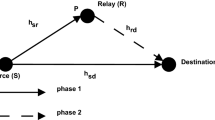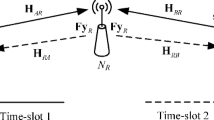Abstract
In this paper, the issue of secondary network access in cognitive wireless sensor networks is investigated. An efficient scheme (in terms of both power and spectrum) named decode-and-forward based multi-relay scheme with relay ordering (DF-MRRO) is proposed for secondary network access. More important, this scheme is used to enhance the performance of secondary network. In an effort to assess the performance, the received signal-to interference-plus-noise ratio of both the primary and secondary links are derived, from which new exact closed-form expressions for the outage probability of primary and secondary networks are derived. Moreover, the diversity order is calculated for both the primary and secondary network. It is also shown that full diversity order can be achieved if the condition of power requirement is satisfied. Finally, simulation results obtained for the outage performance of the proposed scheme in primary and secondary networks prove the effectiveness of the proposed scheme. It also demonstrates that a maximum of 7 dB SNR gain can be achieved in the proposed DF-MRRO scheme.









Similar content being viewed by others
Data availability
No datasets were generated.
References
Ganesan, G., & Li, Y. G. (2007). Cooperative spectrum sensing in cognitive radio, part I: Two user networks. IEEE Transactions on Wireless Communications, 6(6), 2204–2213.
Jaafar, W., Ajib, W., & Haccoun, D. (2013). Adaptive relaying scheme for cognitive radio networks. IET Communications, 7(11), 1151–1162.
Liang, Y.-C., Chen, K.-C., Li, G. Y., & Mähönen, P. (2011). Cognitive radio networking and communications: An overview. IEEE Transactions on Vehicular Technology, 60(7), 3386–3407.
Weiss, T., & Jondral, F. (2004). Spectrum pooling: An innovative strategy for the enhancement of spectrum efficiency. IEEE Communications Magazine, 42(3), S8–S14.
Vijay, G., Bdira, E. B. A., & Ibnkahla, M. (2011). Cognition in wireless sensor networks: A perspective. IEEE Sensors Journal, 11(3), 582–592.
Joshi, G. P., Nam, S. Y., & Kim, S. W. (2013). Cognitive radio wireless sensor networks: Applications, challenges and research trends. Sensors Journal, 13, 11196–21128.
Akan, O. B., Karli, O. B., & Ergul, O. (2009). Cognitive radio sensor networks. IEEE Networks, 23(4), 34–40.
Bicen, A. O., Gungor, V. C., & Akan, O. B. (2012). Delay-sensitive and multimedia communication in cognitive radio sensor networks. Ad Hoc Networks, 10(5), 816–830.
Laneman, J., Tse, D., & Wornell, G. (2004). Cooperative diversity in wireless networks: Efficient protocols and outage behavior. IEEE Transactions on Information Theory, 50(12), 3062–3080.
Jaafar, W., Ajib, W., & Haccoun, D. (2014). On the performance of multi-hop wireless relay networks. Wireless Communications and Mobile Computing, 14(1), 145–160.
Wang, C.-L., Cho, T.-N., & Yang, K.-J. (2013). On power allocation and relay selection for a two-way amplify-and-forward relaying system. IEEE Transactions on Communications, 61(8), 3146–3155.
Hong, J., Hong, B., Ban, T.-W., & Choi, W. (2012). On the cooperative diversity gain in underlay cognitive radio systems. IEEE Transactions on Communications, 60(1), 209–219.
Salameh, O. I., Turck, K. D., Bruneel, H., Blondia, C., & Wittevrongel, S. (2014). On the performance of secondary users in a cognitive radio network. International Conference on Analytical and Stochastic Modelling Techniques and Applications, 8499, 2018–2222.
Zou, Y., Yao, Y. D., & Zheng, B. (2012). Cooperative relay techniques for cognitive radio systems: Spectrum sensing and secondary user transmissions. IEEE Communications Magazine, 50(4), 98–103.
Tellambura, C., & Kusaladharma, S. (2017). An overview of cognitive radio networks. In Wiley encyclopedia of electrical and electronics engineering.
Yi, Z., & Kim, I.-M. (2009). Relay ordering in a multi-hop cooperative diversity network. IEEE Transactions on Communications, 57, 2590–2596.
Fang, H., Lin, X., & Lok, T. M. (2012). Power allocation for multiuser cooperative communication networks under relay-selection degree bounds. IEEE Transactions on Vehicular Technology, 61(7), 2991–3001.
Nguyen, H. X., Nguyen, H. H., & Le-Ngoc, T. (2010). Diversity analysis of relay selection schemes for two-way wireless relay networks. Wireless Personal Communications, 59(2), 173–189. https://doi.org/10.1007/s11277-009-9911-0
Bassily, R., & Ulukus, S. (2013). Deaf cooperation and relay selection strategies for secure communication in multiple relay networks. IEEE Transactions on Signal Processing, 61(6), 1544–1554.
Atapattu, S., Jjing, Y., Jiangand, H., & Tellambura, C. (2013). Relay selection schemes and performance analysis for two-way relay networks. IEEE Transactions on Communications, 61(3), 987–998.
Krikidis, I., Charalambous, T., & Thompson, J. S. (2012). Buffer-aided relay selection for cooperative diversity systems without delay constraints. IEEE Transations on Wireless Communications, 11(5), 1957–1967.
Ju, M., Kim, I. M., & Kim, D. I. (2012). Joint relay selection and relay ordering for DF-based cooperative relay networks. IEEE Transactions on Communications, 60(4), 908–915.
Duy, T. T., & Kong, H. Y. (2012). Performance analysis of two-way hybrid decode-and-amplify relaying scheme with relay selection for secondary spectrum access. Wireless Personal Communications. https://doi.org/10.1007/s11277-012-0616-4
Son, P. N., & Kong, H. Y. (2014). Performance analysis of decode-and-forward scheme with relay ordering for secondary spectrum access. Wireless Personal Communications. https://doi.org/10.1007/s11277-014-1842-8
Jaafar, W., Ajib, W., & Haccoun, D. (2014). A Cooperative transmission scheme for improving the secondary access in cognitive radio networks. IEEE Transactions on Wireless Communications, 13(11), 6219–6231.
Wang, H., Yao, Y. D., & Peng, S. (2018). Prioritized secondary user access control in cognitive radio networks. IEEE Access, 6, 11007–11016. https://doi.org/10.1109/ACCESS.2018.2811341
Yang, Y., Dai, L., Li, J., Mumtaz, S., & Rodriguez, J. (2017). Optimal spectrum access and power control of secondary users in cognitive radio networks. EURASIP Journal on Wireless Communications and Networking. https://doi.org/10.1186/s13638-017-0876-5
El-Toukhey, A. T., Ammar, A. A., Tantawy, M. M., & Tarrad, I. F. (2017). Performance analysis of different opportunistic access based on secondary users priority using licensed channels in cognitive radio networks. In 34th National radio science conference (NRSC) (pp. 160–169). https://doi.org/10.1109/nrsc.2017.7893500
Arzykulov, S., Nauryzbayev, G., Tsiftsis, T. A., Maham, B., & Abdallah, M. (2019). On the outage of underlay CR-NOMA networks with detect-and-forward relaying. IEEE Transactions on Cognitive Communications and Networking, 5(3), 795–804. https://doi.org/10.1109/tccn.2019.2916561
Aulakh, I. K., & Vig, R. (2014). Optimization of secondary user access in cognitive radio networks. In Recent advances in engineering and computational sciences (RAECS) (pp. 1–6). https://doi.org/10.1109/RAECS.2014.6799511
Liu, X., Sun, Q., Lu, W., Wu, C., & Ding, H. (2020). Big-data-based intelligent spectrum sensing for heterogeneous spectrum communications in 5G. IEEE Wireless Communications, 27(5), 67–73. https://doi.org/10.1109/MWC.001.1900493
Liu, X., Sun, C., Zhou, M., Wu, C., Peng, B., & Li, P. (2021). Reinforcement learning-based multislot double-threshold spectrum sensing with Bayesian fusion for industrial big spectrum data. IEEE Transactions on Industrial Informatics, 17(5), 3391–3400. https://doi.org/10.1109/TII.2020.2987421
Liu, X., & Zhang, X. (2020). NOMA-based resource allocation for cluster-based cognitive industrial internet of things. IEEE Transactions on Industrial Informatics, 16(8), 5379–5388. https://doi.org/10.1109/TII.2019.2947435
Hassen, T. W. (2012). Synchronization in cognitive overlay systems, 1st ed. M.S. thesis, Department of Electrical Engineering and Automation, Aalto University, Espoo, Finland.
He, S., Jiang, L., He, C. (2012). A novel secondary user assisted relay mechanism in cognitive radio networks with multiple primary users. In Proceedings of IEEE GLOBECOM (pp. 1254–1259).
Masri, A., Dama, Y. A. S., Mousa, A., & Hasan, F. (2015). Distributed synchronization protocol for secondary overlay access in cognitive radio networks. Internet Technologies and Applications. https://doi.org/10.1109/ITechA.2015.7317445
Yiang, Q., Zhang, X., Qian, J., & Ye, Q. (2018). An anomaly node detection method for distributed time synchronization algorithm in cognitive radio sensor networks. International Journal of Distributed Sensor Networks. https://doi.org/10.1177/1550147718774467
Funding
Not applicable.
Author information
Authors and Affiliations
Contributions
SD has designed the given model and computational framework and analyzed the data. She carried out the implementation part and contributed for the interpretation of the results. JMLM has provided feedback and helped to shape the manuscript. XA helped to analyze the throughput of the proposed system.
Corresponding author
Ethics declarations
Conflict of interest
The authors declare that they have no conflict of interest.
Additional information
Publisher's Note
Springer Nature remains neutral with regard to jurisdictional claims in published maps and institutional affiliations.
Appendices
Appendix 1
At high SNR, Eq. (28) can be approximated as
where
The outage probability of primary link for each possible set of C can be approximated as
If all secondary transmitters can decode successfully i.e.\(C = \left\{ {ST_{1} ,ST_{2} , \ldots ,ST_{N} } \right\}\) and \(D = \left\{ \emptyset \right\}\), the outage probability can be written as
At high SNR, the above equation can be approximated as
where
Moreover, we have
Hence, outage probability at high SNR can be given as
The diversity order is calculated as follows: Diversity Order
Appendix 2
At high SNR, Eqs. (28) and (30) can be approximated as
where
The outage probability for each possible set of \(C_{j}\) is approximated as
where
If all the secondary transmitters \(ST_{1} ,ST_{2} ,...,ST_{j - 1}\) can decode the primary signal \(x_{s}\) successfully, the above equation can be approximated as
It is easy to see that \(\left( {j - n - 1} \right)\left( {m - y} \right) + 1 \ge j - n \ge 1\). Hence the outage probability of the secondary network can be approximated at high SNR as
where \(\varsigma_{j}\) is a constant. The outage probability of secondary system can be calculated as
From the definition of diversity order, the diversity gain of STj-SRj link and secondary system are calculated as 1 and N respectively.
Rights and permissions
About this article
Cite this article
Devipriya, S., Martin Leo Manickam, J. & Anita, X. On the outage performance of decode-and-forward based relay ordering in cognitive wireless sensor networks. Wireless Netw 28, 3247–3259 (2022). https://doi.org/10.1007/s11276-022-03038-1
Accepted:
Published:
Issue Date:
DOI: https://doi.org/10.1007/s11276-022-03038-1




